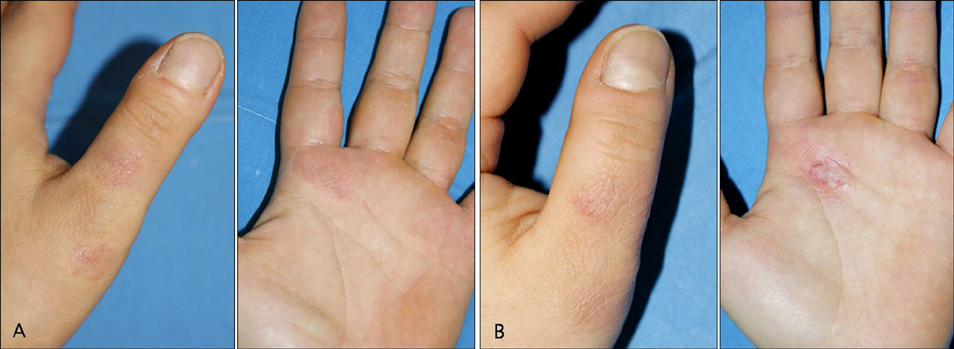Ann Dermatol.
2010 Feb;22(1):63-65. 10.5021/ad.2010.22.1.63.
A Case of Chromium Contact Dermatitis due to Exposure from a Golf Glove
- Affiliations
-
- 1Department of Dermatology, Seoul St. Mary's Hospital, College of Medicine, The Catholic University of Korea, Seoul, Korea. hokim27@empal.com
- KMID: 2172041
- DOI: http://doi.org/10.5021/ad.2010.22.1.63
Abstract
- Chromium is a transition metal and has been shown to elicit contact dermatitis. Although leather products have been known to be the most significant source of chromium exposure these days, the majority of reports have been related to exposure from shoe products. We herein report a professional golfer who became allergic to golf gloves made of chromium-tanned leather. A 27-year-old woman golfer presented with recurrent, pruritic, erythematous plaques that had been occurring on both hands for several years. The lesions developed whenever she had worn golf gloves for an extended period of time, especially during tournament season. To identify the causative agent, patch tests were performed and the results demonstrated a strong positive reaction to potassium dichromate 0.5% and to her own glove. The amount of chromium in her golf glove was analyzed to be 308.91 ppm and based on this, a diagnosis of allergic contact dermatitis due to a chromium-tanned leather glove was made. She was treated with oral antihistamines combined with topical steroids and advised to wear chromium-free leather gloves. There has been no evidence of recurrence during a six month follow-up period.
Keyword
MeSH Terms
Figure
Reference
-
1. Andersen PH, Nangia A, Bjerring P, Maibach HI. Chemical and pharmacologic skin irritation in man. A reflectance spectroscopic study. Contact Dermatitis. 1991. 25:283–289.2. Hansen MB, Rydin S, Menne T, Duus Johansen J. Quantitative aspects of contact allergy to chromium and exposure to chrome-tanned leather. Contact Dermatitis. 2002. 47:127–134.
Article3. Suh DH, Eun HC. An analysis of chrome in cements and bleaching detergents. Korean J Dermatol. 1990. 28:11–15.4. Yoo HD, Lee MH, Choi JM, Haw CR. An analysis of chrome in brassieres. Korean J Dermatol. 1994. 32:620–625.5. Kim BJ, Li K, Woo SM, Cho WI, Cho SY, Kim MN, et al. Clinical observation of cellular phone dermatitis in Korea. Korean J Dermatol. 2006. 44:35–39.6. Basketter D, Horev L, Slodovnik D, Merimes S, Trattner A, Ingber A. Investigation of the threshold for allergic reactivity to chromium. Contact Dermatitis. 2001. 44:70–74.
Article7. Zachariae CO, Agner T, Menne T. Chromium allergy in consecutive patients in a country where ferrous sulfate has been added to cement since 1981. Contact Dermatitis. 1996. 35:83–85.
Article8. Nygren O, Wahlberg JE. Speciation of chromium in tanned leather gloves and relapse of chromium allergy from tanned leather samples. Analyst. 1998. 123:935–937.
Article9. Hansen MB, Menne T, Johansen JD. Cr(III) and Cr(VI) in leather and elicitation of eczema. Contact Dermatitis. 2006. 54:278–282.
Article10. Graf D. Formation of Cr(VI) traces in chrome-tanned leather: causes, prevention and latest findings. J Am Leather Chem Assoc. 2001. 96:169–179.11. Shelnutt SR, Goad P, Belsito DV. Dermatological toxicity of hexavalent chromium. Crit Rev Toxicol. 2007. 37:375–387.
Article12. Hansen MB, Johansen JD, Menne T. Chromium allergy: significance of both Cr(III) and Cr(VI). Contact Dermatitis. 2003. 49:206–212.
Article
- Full Text Links
- Actions
-
Cited
- CITED
-
- Close
- Share
- Similar articles
-
- Clinical Characteristics of Patients with Chromium Allergy in a Single University Hospital in Korea
- A Case of Allergic Contact Dermatitis Due to Rubber Glove and Cement
- A Case of Irritant Contact Dermafitis Due to Ranuculus japonicus
- A Case of Irritant Contact Dermatitis due to Fiberglass in a Construction Worker
- A Case of Occupational Asthma Associated with Chromium



